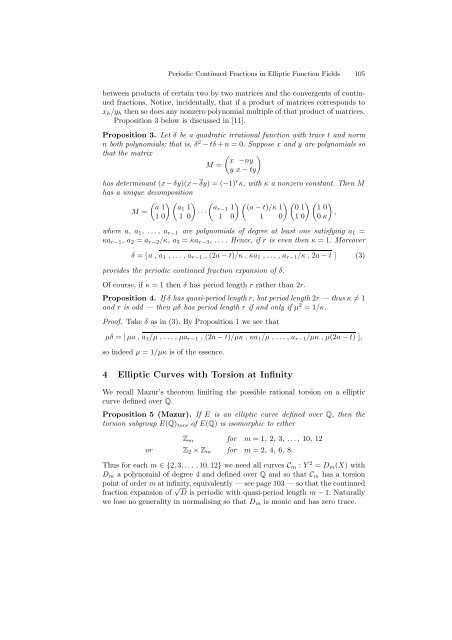Periodic Continued Fractions in Elliptic Function Fields - Macquarie ...
Periodic Continued Fractions in Elliptic Function Fields - Macquarie ...
Periodic Continued Fractions in Elliptic Function Fields - Macquarie ...
You also want an ePaper? Increase the reach of your titles
YUMPU automatically turns print PDFs into web optimized ePapers that Google loves.
<strong>Periodic</strong> <strong>Cont<strong>in</strong>ued</strong> <strong>Fractions</strong> <strong>in</strong> <strong>Elliptic</strong> <strong>Function</strong> <strong>Fields</strong> 105<br />
between products of certa<strong>in</strong> two by two matrices and the convergents of cont<strong>in</strong>ued<br />
fractions. Notice, <strong>in</strong>cidentally, that if a product of matrices corresponds to<br />
xh/yh then so does any nonzero polynomial multiple of that product of matrices.<br />
Proposition 3 below is discussed <strong>in</strong> [11].<br />
Proposition 3. Let δ be aquadratic irrational function with trace t and norm<br />
n both polynomials; that is, δ2 − tδ + n =0. Suppose x and y are polynomials so<br />
that the matrix<br />
<br />
x −ny<br />
M =<br />
yx− ty<br />
has determ<strong>in</strong>ant (x − δy)(x − δy) =(−1) rκ, with κ a nonzero constant. Then M<br />
has a unique decomposition<br />
<br />
a 1 a1 1 ar−1 1 (a − t)/κ 1 01 10<br />
M =<br />
···<br />
,<br />
10 1 0 1 0 1 0 10 0 κ<br />
where a, a1, ..., ar−1 are polynomials of degree at least one satisfy<strong>in</strong>g a1 =<br />
κar−1, a2 = ar−2/κ, a3 = κar−3, .... Hence, if r is even then κ =1. Moreover<br />
δ =[a,a1 ,...,ar−1 , (2a − t)/κ , κa1 , ...,ar−1/κ , 2a − t ] (3)<br />
provides the periodic cont<strong>in</strong>ued fraction expansion of δ.<br />
Of course, if κ =1then δ has period length r rather than 2r.<br />
Proposition 4. If δ has quasi-period length r, but period length 2r — thus κ = 1<br />
and r is odd — then µδ has period length r if and only if µ 2 =1/κ.<br />
Proof. Take δ as <strong>in</strong> (3). By Proposition 1 we see that<br />
µδ =[µa , a1/µ ,...,µar−1 , (2a − t)/µκ , κa1/µ , . ..,ar−1/µκ , µ(2a − t) ],<br />
so <strong>in</strong>deed µ =1/µκ is of the essence.<br />
4 <strong>Elliptic</strong> Curves with Torsion at Inf<strong>in</strong>ity<br />
We recall Mazur’s theorem limit<strong>in</strong>g the possible rational torsion on a elliptic<br />
curve def<strong>in</strong>ed over Q.<br />
Proposition 5 (Mazur). If E is an elliptic curve def<strong>in</strong>ed over Q, then the<br />
torsion subgroup E(Q)tors of E(Q) is isomorphic to either<br />
Zm for m =1, 2, 3, ..., 10, 12<br />
or Z2 × Zm for m =2, 4, 6, 8.<br />
Thus for each m ∈{2, 3,... ,10, 12} we need all curves Cm : Y 2 = Dm(X) with<br />
Dm apolynomial of degree 4 and def<strong>in</strong>ed over Q and so that Cm has a torsion<br />
po<strong>in</strong>t of order m at <strong>in</strong>f<strong>in</strong>ity, equivalently — see page 103 — so that the cont<strong>in</strong>ued<br />
fraction expansion of √ D is periodic with quasi-period length m − 1. Naturally<br />
we lose no generality <strong>in</strong> normalis<strong>in</strong>g so that Dm is monic and has zero trace.

















